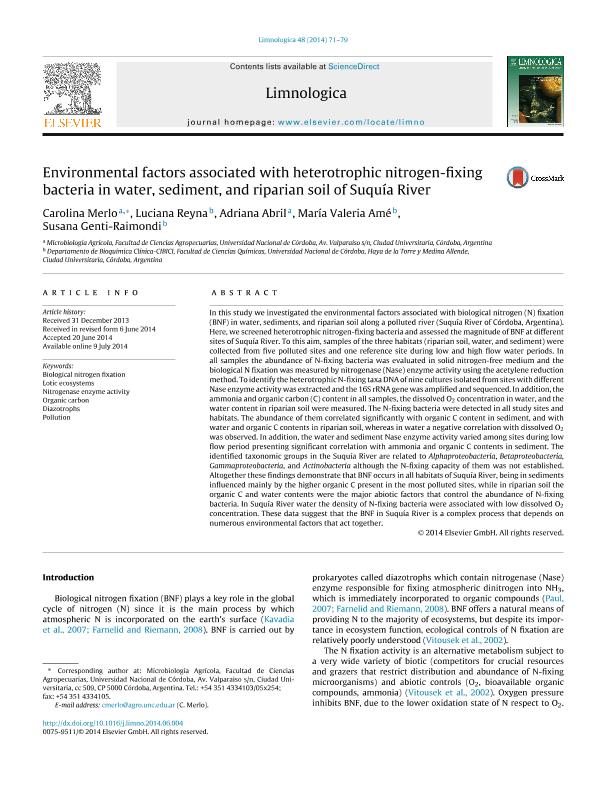Mostrar el registro sencillo del ítem
dc.contributor.author
Merlo, Carolina

dc.contributor.author
Reyna, Luciana

dc.contributor.author
Abril, Adriana

dc.contributor.author
Amé, María Valeria

dc.contributor.author
Genti de Raimondi, Susana

dc.date.available
2017-12-28T19:18:31Z
dc.date.issued
2014-07
dc.identifier.citation
Genti de Raimondi, Susana; Amé, María Valeria; Abril, Adriana; Reyna, Luciana; Merlo, Carolina; Environmental factors associated with heterotrophic nitrogen-fixing bacteria in water, sediment, and riparian soil of Suquía River; Elsevier Gmbh; Limnologica; 48; 7-2014; 71-79
dc.identifier.issn
0075-9511
dc.identifier.uri
http://hdl.handle.net/11336/31863
dc.description.abstract
In this study we investigated the environmental factors associated with biological nitrogen (N) fixation (BNF) in water, sediments, and riparian soil along a polluted river (Suquía River of Córdoba, Argentina). Here, we screened heterotrophic nitrogen-fixing bacteria and assessed the magnitude of BNF at different sites of Suquía River. To this aim, samples of the three habitats (riparian soil, water, and sediment) were collected from five polluted sites and one reference site during low and high flow water periods. In all samples the abundance of N-fixing bacteria was evaluated in solid nitrogen-free medium and the biological N fixation was measured by nitrogenase (Nase) enzyme activity using the acetylene reduction method. To identify the heterotrophic N-fixing taxa DNA of nine cultures isolated from sites with different Nase enzyme activity was extracted and the 16S rRNA gene was amplified and sequenced. In addition, the ammonia and organic carbon (C) content in all samples, the dissolved O2 concentration in water, and the water content in riparian soil were measured. The N-fixing bacteria were detected in all study sites and habitats. The abundance of them correlated significantly with organic C content in sediment, and with water and organic C contents in riparian soil, whereas in water a negative correlation with dissolved O2 was observed. In addition, the water and sediment Nase enzyme activity varied among sites during low flow period presenting significant correlation with ammonia and organic C contents in sediment. The identified taxonomic groups in the Suquía River are related to Alphaproteobacteria, Betaproteobacteria, Gammaproteobacteria, and Actinobacteria although the N-fixing capacity of them was not established. Altogether these findings demonstrate that BNF occurs in all habitats of Suquía River, being in sediments influenced mainly by the higher organic C present in the most polluted sites, while in riparian soil the organic C and water contents were the major abiotic factors that control the abundance of N-fixing bacteria. In Suquía River water the density of N-fixing bacteria were associated with low dissolved O2 concentration. These data suggest that the BNF in Suquía River is a complex process that depends on numerous environmental factors that act together.
dc.format
application/pdf
dc.language.iso
eng
dc.publisher
Elsevier Gmbh

dc.rights
info:eu-repo/semantics/openAccess
dc.rights.uri
https://creativecommons.org/licenses/by-nc-sa/2.5/ar/
dc.subject
Biological Nitrogen Fixation
dc.subject
Lotic Ecosystems
dc.subject
Nitrogenase Enzyme Activity
dc.subject
Organic Carbon
dc.subject
Diazotrophs
dc.subject
Pollution
dc.subject.classification
Meteorología y Ciencias Atmosféricas

dc.subject.classification
Ciencias de la Tierra y relacionadas con el Medio Ambiente

dc.subject.classification
CIENCIAS NATURALES Y EXACTAS

dc.title
Environmental factors associated with heterotrophic nitrogen-fixing bacteria in water, sediment, and riparian soil of Suquía River
dc.type
info:eu-repo/semantics/article
dc.type
info:ar-repo/semantics/artículo
dc.type
info:eu-repo/semantics/publishedVersion
dc.date.updated
2017-12-28T18:23:24Z
dc.journal.volume
48
dc.journal.pagination
71-79
dc.journal.pais
Alemania

dc.journal.ciudad
Berlin
dc.description.fil
Fil: Merlo, Carolina. Universidad Nacional de Córdoba. Facultad de Ciencias Agropecuarias; Argentina. Consejo Nacional de Investigaciones Científicas y Técnicas; Argentina
dc.description.fil
Fil: Reyna, Luciana. Consejo Nacional de Investigaciones Científicas y Técnicas. Centro Científico Tecnológico Córdoba. Centro de Investigaciones en Bioquímica Clínica e Inmunología; Argentina
dc.description.fil
Fil: Abril, Adriana. Universidad Nacional de Córdoba. Facultad de Ciencias Agropecuarias; Argentina. Consejo Nacional de Investigaciones Científicas y Técnicas; Argentina
dc.description.fil
Fil: Amé, María Valeria. Consejo Nacional de Investigaciones Científicas y Técnicas. Centro Científico Tecnológico Córdoba. Centro de Investigaciones en Bioquímica Clínica e Inmunología; Argentina
dc.description.fil
Fil: Genti de Raimondi, Susana. Consejo Nacional de Investigaciones Científicas y Técnicas. Centro Científico Tecnológico Córdoba. Centro de Investigaciones en Bioquímica Clínica e Inmunología; Argentina
dc.journal.title
Limnologica

dc.relation.alternativeid
info:eu-repo/semantics/altIdentifier/doi/http://dx.doi.org/10.1016/j.limno.2014.06.004
dc.relation.alternativeid
info:eu-repo/semantics/altIdentifier/url/http://www.sciencedirect.com/science/article/pii/S0075951114000413
Archivos asociados
